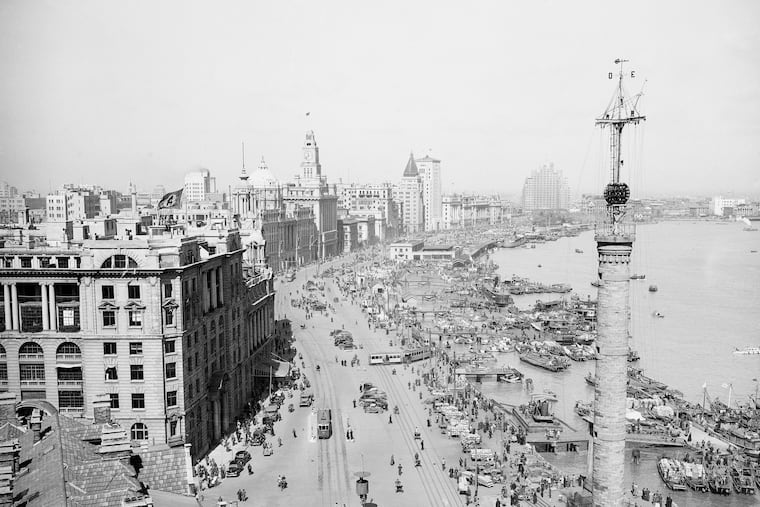As Chinese New Year arrives, a story of refugees past and present
In 1949, as Mao’s revolutionary army advanced on Shanghai, thousands of people in China’s most Westernized city faced the same life-altering decision: Stay or go?

The Chinese New Year arrives Tuesday, and with it a story about a largely forgotten exodus — one that loudly resonates today.
In 1949, as Mao’s revolutionary army advanced on Shanghai, thousands of people in China’s most Westernized city faced the same life-altering decision:
Stay or go?
And if the answer was go, then where? Taiwan? Hong Kong? Many hoped to find haven in the United States but knew that others had been turned away.
People who had comfortable lives in China’s wealthiest city were suddenly transformed into refugees.
It’s a story that echoes in a modern world riven by refugee crises and in a country where foreigners are not always welcome, said scholar, activist, and journalist Helen Zia, author of the new Last Boat Out of Shanghai: The Epic Story of the Chinese Who Fled Mao’s Revolution.
“Refugees flee not because they want to but because they don’t know if they’re going to live [if they stay],” Zia said. “That’s what drives people today to walk a thousand miles holding their baby.”
Zia, who grew up in Willingboro and now lives in the San Francisco Bay Area, will discuss and sign copies of Last Boat in Philadelphia this week: first at the Organization of Chinese Americans of Greater Philadelphia’s New Year luncheon, set for noon Feb. 3 at Vietnam Palace in Chinatown. And two days later, Feb. 5 at 5:30 p.m. at the Penn Book Center in University City.
She interviewed hundreds of exiles for her book, which focuses on the lives and choices of four.
Today an estimated 68.5 million people around the globe have been forced from their homes, according to the United Nations. About 25.4 million of them are classified as refugees, driven not just from their homes but from their countries by war, violence, or persecution.
Worldwide, one person is forcibly displaced every two seconds.
The fall of Shanghai played out over months.
All of China suffered under the Japanese invasion of the late 1930s and early 1940s. But in the late ’40s, it became clear the Communists would defeat the Nationalists in the Chinese civil war, and when that happened, Shanghai would pay a price.
The city was the peer of places like London, home to intellectuals, artists, businesspeople, and a thriving middle class. Many residents of “the Paris of the Orient” were terrified of what the Communists might do to them — as many face fear and torment in other lands today.
Nationalist propaganda warned of mass arrests and killings, inciting panic. People piled aboard ships and planes, certain the Communists would take their property and businesses and even their wives.
“Running away seemed unthinkable when everything they knew and valued was right there in Shanghai,” Zia wrote. “Fleeing would mean splitting up families,” but like “the German Jews who had escaped Hitler’s Berlin, Vietnamese waiting for helicopters on the roof of the U.S. Embassy in Saigon, or Syrians dodging bombs and bullets to brave the Mediterranean Sea, they fled.”
The people who got out were those who had means — not just money but education and connections. They had the ability to secure a ticket at a moment when everyone wanted one.
“Bing was one of the lucky ones,” Zia writes of her mother, Bing Woo, then about 20. “She possessed a precious one-way ticket out. On a ship. To America.”
The People’s Liberation Army marched into Shanghai on May 25, 1949. Estimates are that a million people fled through the city during the first years of Communist rule.
Zia’s parents met in New York City. Each had entered the country legally, and stayed when their visas expired, becoming undocumented refugees. In 1955, Zia said, they were told they would be deported. Ultimately, immigration officials relented, citing the hardship that would cause to the couple’s American-born, American-citizen children.
Zia was about 6 when her family moved from Metuchen, N.J., to Willingboro in 1957 or 1958, helping integrate a growing suburban community. In those baby-boom days, many fathers were military veterans who had fought against Germany and Japan in World War II or served in the more recent Korean War. Vietnam loomed as a new battlefield.
“There were some teachers who were not so friendly,” Zia recalled. “When they saw us, they saw the enemy.”
Zia’s father wrote letters to local newspapers, including the Inquirer, criticizing U.S. government policy toward China. That brought the FBI to Willingboro, where agents knocked on the doors of the family’s neighbors.
Zia graduated from John F. Kennedy High School in 1970, earned her college degree at Princeton University, became a Fulbright scholar, and received an honorary doctor of laws degree from the Law School of the City University of New York.
Many descendants of the Shanghai refugees became successful. People like architect Maya Lin, authors Gish Jen and Amy Tan, and government executive Elaine Chao, the U.S. secretary of transportation and former secretary of labor.
It still happens today, Zia said, when people fleeing war and violence are given a chance to build an American dream for themselves and their children.
“We are seeing people traumatized around the world,” Zia said. “And in this country, how many millions of people are living in the same uncertainty: ‘Am I going to be deported? Am I going to be separated from my children, my babies?’ Maybe we can stop repeating history and learn from it.”